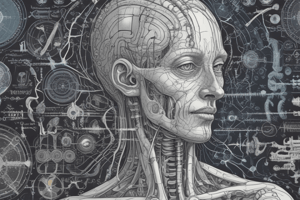Podcast
Questions and Answers
What is the primary characteristic of Treacher Collins syndrome?
What is the primary characteristic of Treacher Collins syndrome?
- Underdevelopment or absence of the cheekbones, mandibular bone, and lower eyelids (correct)
- Hearing loss due to issues with the middle ear bones
- Affects the development and structure of the skull, collarbone, and jaw
- Small chin, missing teeth, and delayed tooth eruption
Which of the following is NOT a feature of cleidocranial dysostosis?
Which of the following is NOT a feature of cleidocranial dysostosis?
- Missing teeth
- Hearing loss (correct)
- Delayed tooth eruption
- Small chin
What is the genetic inheritance pattern for both Treacher Collins syndrome and cleidocranial dysostosis?
What is the genetic inheritance pattern for both Treacher Collins syndrome and cleidocranial dysostosis?
- Autosomal dominant (correct)
- X-linked dominant
- Mitochondrial
- Autosomal recessive
Which of the following is NOT a potential challenge associated with the mandibular and palate disorders discussed?
Which of the following is NOT a potential challenge associated with the mandibular and palate disorders discussed?
What is the importance of understanding the genetic basis of these disorders?
What is the importance of understanding the genetic basis of these disorders?
Which of the following statements about the mandibular and palate disorders discussed is true?
Which of the following statements about the mandibular and palate disorders discussed is true?
What genetic pattern is associated with Aniridia?
What genetic pattern is associated with Aniridia?
Which of the following is a characteristic of Retinitis Pigmentosa?
Which of the following is a characteristic of Retinitis Pigmentosa?
In Otopalatodigital syndrome, patients may have abnormalities in all of the following areas EXCEPT:
In Otopalatodigital syndrome, patients may have abnormalities in all of the following areas EXCEPT:
What part of the eye is affected in Aniridia?
What part of the eye is affected in Aniridia?
Which of the following is true about autosomal dominant inheritance?
Which of the following is true about autosomal dominant inheritance?
Which of the following conditions results in underdeveloped or malformed ears?
Which of the following conditions results in underdeveloped or malformed ears?
Study Notes
Defects in Eyes, Ears, Mandible, and Palate Autosomal Dominant
Autosomal dominant inheritance is a pattern of genetic transmission where a gene mutation on one of the pairs of homologous chromosomes results in the manifestation of a trait or condition in the offspring. When it comes to defects in the eyes, ears, mandible, and palate, several conditions follow this mode of inheritance. Here, we will discuss some of these disorders in detail.
Eye Disorders
Aniridia
Aniridia is an autosomal dominant genetic disorder characterized by the absence of irises (the colored part) of the eye. In this condition, the iris is replaced by a thin, transparent membrane, exposing the underlying structures of the eye.
Retinitis Pigmentosa
Retinitis pigmentosa is an autosomal dominant genetic condition that affects the retina, leading to progressive vision loss. It is characterized by the degeneration of photoreceptor cells in the retina, which can result in night blindness and eventual complete blindness.
Ear Disorders
Otopalatodigital Syndrome
Otopalatodigital syndrome is an autosomal dominant genetic disorder that affects the development of the ears, eyes, and limbs. Patients with this syndrome typically have underdeveloped or malformed ears, as well as other abnormalities such as cleft palate, dental abnormalities, and short or abnormal limbs.
Mandibular Disorders
Treacher Collins Syndrome
Treacher Collins syndrome is an autosomal dominant genetic disorder characterized by underdevelopment or absence of the cheekbones, mandibular bone, and lower eyelids. It is often associated with hearing loss due to issues with the middle ear bones.
Palate Disorders
Cleidocranial Dysostosis
Cleidocranial dysostosis is an autosomal dominant condition that affects the development and structure of the skull, collarbone, and jaw. Individuals with cleidocranial dysostosis typically have a small chin, missing teeth, delayed tooth eruption, and a wide skull base.
These conditions represent just a few examples of the various disorders that follow autosomal dominant inheritance patterns and affect the eyes, ears, mandible, and palate. Each condition presents unique challenges and requires specialized care and treatment. Understanding the genetic basis of these disorders is crucial for early diagnosis, appropriate management, and potential future treatments or even preventative measures.
Studying That Suits You
Use AI to generate personalized quizzes and flashcards to suit your learning preferences.
Description
Test your knowledge on autosomal dominant genetic disorders affecting the eyes, ears, mandible, and palate with this quiz. Explore conditions like aniridia, retinitis pigmentosa, Treacher Collins syndrome, and more. Understand inheritance patterns and manifestations of these disorders.





